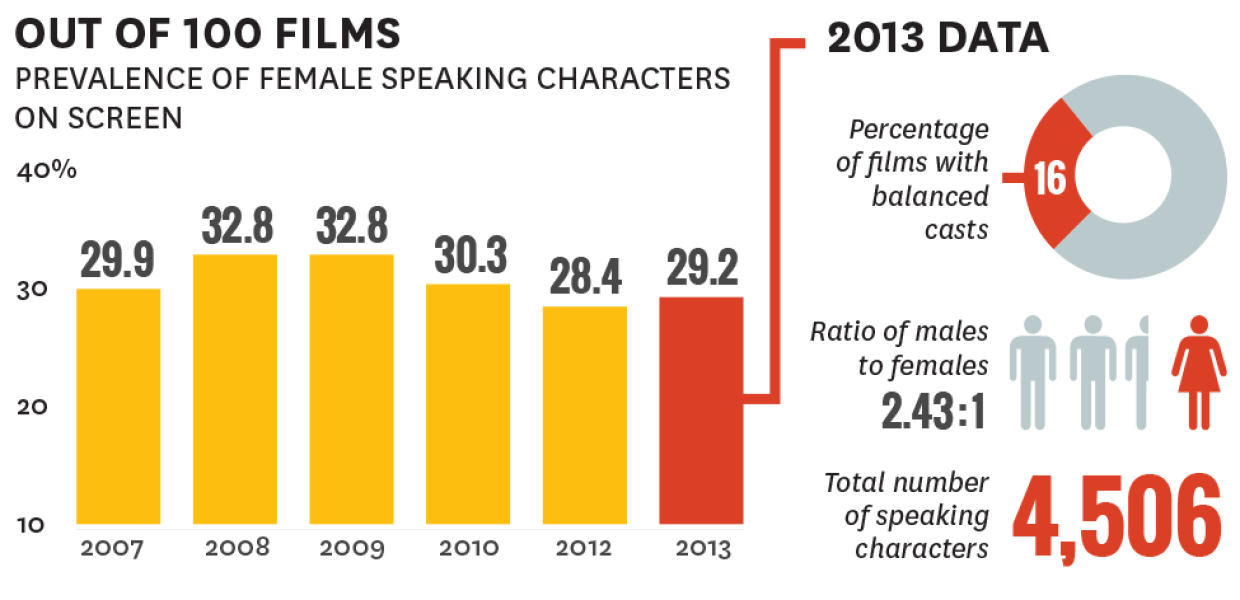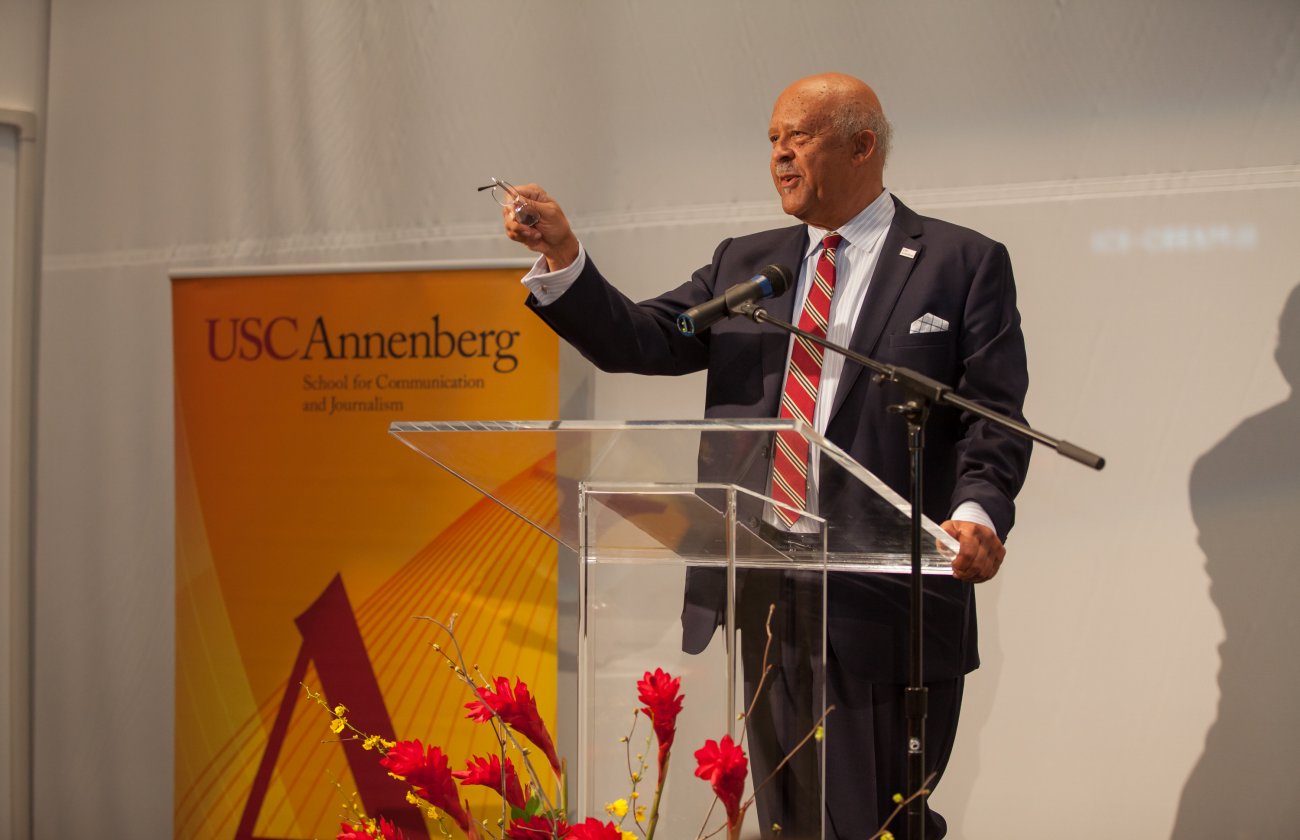Anna and Elsa managed to rescue their kingdom from perpetual winter, but the challenge they face now is to save other female characters and actors from being frozen out of speaking roles in film.
A new study from the Media, Diversity, & Social Change Initiative at USC Annenberg reveals that less than a third of all speaking characters are female across six years and 600 films. In 2013, females represented just 29.2 percent of all speaking characters. The researchers assessed every character who spoke one or more words on screen — over 25,000 characters in all from the top grossing films released in 2007, 2008, 2009, 2010, 2012, and 2013. The report is the largest, most comprehensive analysis of gender prevalence in recent film to date.
“Our findings this year are both familiar and phenomenal,” said USC Annenberg Professor Stacy L. Smith, author of the study and founding director of the Initiative. “Female characters are consistently underrepresented in the most popular films each year. However, there are reasons to believe that Hollywood can and does change.”

One positive finding is that women were most likely to be seen in comedy films, where 36 percent of characters were female in 2007, 2010, and 2013.
“Women like Amy Poehler, Tina Fey, Kristin Wiig, and Melissa McCarthy are true trailblazers and just a few of the reasons that women are making strides in comic films,” said Professor Smith.
Two other genres stood out to the researchers as areas that need improvement. “Activists and advocates should take aim at action/adventure and animation films,” said Professor Smith. These genres featured the lowest percentages of women. Less than a quarter of the characters in action/adventure films were female 20 to 23.9 percent, and in animation, gains between 2007 and 2010 were balanced out by a drop to 24.6 percent in 2013.
The report also examines how women are depicted on screen. Female characters are significantly more likely than male characters to be shown in sexually revealing clothing or partially naked, a trend that has been consistent over the past six years.
But 2013 saw one important change — the reversal of a three-year climb in female teen sexualization on screen.
“Teen female hypersexualization decreased by around 17 percent in 2013 from a high in 2012,” said Professor Smith. “What this reveals more than anything is that the trends we observe are not always stable. The numbers can change.”
The study also found bad news for women behind the scenes. 2013 represented a six-year low in the presence of women writers and directors. Just two of the 107 directors in 2013 were female, or 1.9 percent. The percentages of writers (7.4 percent) and producers (19.6 percent) are similarly low. “We need to move beyond asking the industry to change and find solutions that compel decision-makers to diversify their workforce,” said Marc Choueiti, one of the study authors.
A full description of the results and methodology of the study can be found in the report.
This study is the most recent from the MDSC Initiative, which releases yearly in-depth analyses of the prevalence and portrayal of gender and race/ethnicity in film. More than 65 students at the University of Southern California’s Annenberg School for Communication and Journalism worked on the study, including a team of 17 Harnisch Foundation/MDSC interns.
Key Findings:
- Across 4,506 speaking characters evaluated, 29.2 percent were female and 70.8 percent were male in the 100 top-grossing films of 2013. Of these 100 films, 28 percent of the films had a female lead or co-lead. The percentage of female characters in 2013 does not differ from the other years in the sample (2007=29.9 percent; 2008=32.8 percent; 2009=32.8 percent, 2010=30.3 percent; 2012=28.4 percent).
- In 2013, R-rated films (31.2 percent) featured a higher percentage of female speaking characters than PG films (24.9 percent), with PG-13 (28.6 percent) holding a middle position. Only 1 film was rated G.
- The percentage of females by film genre was assessed for films in 2013, 2010, and 2007. Comedy depicted the largest percentage of female characters (2013=36 percent; 2010=36 percent; 2007=36 percent). Action and/or adventure films depict girls and women in less than a quarter of all speaking roles. Animation films depict females in less than a third of all roles, but fluctuate across the years studied.
- Examining gender-balanced casts in 2013 (women in 45-54.9 percent of all speaking roles), only 16 percent of movies included gender parity. One film contained no female speaking characters. Another 12 percent of movies portrayed females in less than 15 percent of the cast and 52 percent of the films depicted girls and women as 15-34.9 percent of the cast. Only 2 percent of films featured more female than male characters.
- Turning to behind the scenes, out of 1,374 directors, writers, and producers credited across the sample, less than a fifth (15.9 percent) of these content creators were women. This calculates into a gender ratio of 5.3 male filmmakers to every 1 female. Only 1.9 percent of directors, 7.4 percent of writers, and 19.6 percent of producers were women. Looking at the film as the unit of analysis, only 2 had a female director attached, 15 had a female writer attached, but 84 had a female producer attached. The number of female directors and writers is at a six-year low.
Portrayal of Male and Female Characters:
- The age of male and female characters was examined. Focusing on the adult category (21-39 years old), females were more likely to be depicted in this age bracket (53.9 percent) than were males (45.3 percent). In contrast, males (39.8 percent) were more likely than females (24.9 percent) to be middle aged (40 to 64 years of age). A full 42.9 percent of children (0-12 yr. olds) on screen were female. Of the teen characters, 41.2 percent were female and 58.8 percent were male.
- Across all six years, slightly more than half of all female characters in film were between 21 and 39 years of age. Less than a quarter of all female roles were for characters between the ages of 40 and 64.
- Differences in the hypersexualization of male and female characters were explored. Females (30.2 percent) were far more likely than males (9.7 percent) to be shown in sexualized attire (i.e., tight or revealing clothing). Females (29.5 percent) were more likely than males to be shown with partial or full nudity (11.7 percent). It was also the case that females were more likely than males to be referenced as physically attractive (13.2 percent vs. 2.4 percent).
- Films in 2013 showed a reversal in a three-year climb in teen hypersexualization. The percentage of female teens depicted in sexy attire or with exposed skin dramatically increased between 2009 and 2012. In 2013, these percentages drop 17.2 percent and 18.4 percent from the previous year. Given that there are so few female teens in the sample, these yearly percentages may fluctuate based on portrayals in a small number of movies. Therefore, the results should be interpreted with caution.
Featured image from Disney's Frozen page on Facebook.










